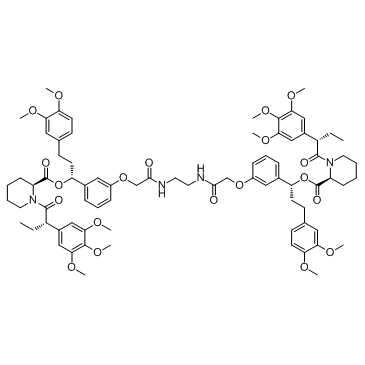195514-63-7
| Name | AP1903 |
|---|---|
| Synonyms |
AP1903
AP-1903 UNII:H564L1W5J2 H564L1W5J2 Rimiducid 2-piperidinecarboxylic acid, 1-[(2S)-1-oxo-2-(3,4,5-trimethoxyphenyl)butyl]-, 1,2-ethanediylbis[imino(2-oxo-2,1-ethanediyl)oxy-3,1-phenylene(1R)-3-(3,4-dimethoxyphenyl)propylidene] ester, (2S,2'S)- ethane-1,2-diylbis[imino(2-oxoethane-2,1-diyl)oxybenzene-3,1-diyl(1R)-3-(3,4-dimethoxyphenyl)propane-1,1-diyl] (2S,2'S)bis{1-[(2S)-2-(3,4,5-trimethoxyphenyl)butanoyl]piperidine-2-carboxylate} 1,2-Ethanediylbis[imino(2-oxo-2,1-ethanediyl)oxy-3,1-phenylene(1R)-3-(3,4-dimethoxyphenyl)-1,1-propanediyl] (2S,2'S)bis{1-[(2S)-2-(3,4,5-trimethoxyphenyl)butanoyl]-2-piperidinecarboxylate} |
| Description | Rimiducid (AP1903) is a dimerizer agent that acts by cross-linking the FKBP domains, initiating Fas signaling and hence apoptosis. |
|---|---|
| Related Catalog | |
| Target |
EC50: 0.1 nM (FKBP, in HT1080 cells)[1] Fas receptor[1] |
| In Vitro | The human fibrosarcoma line HT1080 is engineered to express stably a fusion protein comprising a myristoylation sequence, two copies of F36V-FKBP, and the human first apoptosis signal (Fas) intracellular domain. Rimiducid (AP1903) elicits potent and dose-dependent apoptotic death of these engineered cells in culture, with an EC50 of ≈0.1 nM[1]. Maximal killing occurred in the presence of 3 to 10 nM Rimiducid (AP1903), and the IC50 is approximately 0.2 nM. LV′VFas-transduced T lymphocytes expressing high levels of CD25 (top panel) are eliminated by with 66%±7.5% (n=10) efficiency. When cells are examined after CD25 expression returned to basal levels, 63%±4.7% (n=9) killing is observed after Rimiducid treatment[2]. |
| In Vivo | Rimiducid (AP1903; i.v.,0.01, 0.1, 1, 10, and 100 mg/kg) elicits a dose-dependent decrease in serum hGH levels, with a half-maximal effective dose of 0.4±0.1 mg/kg[1]. |
| Cell Assay | Cloned HT1080 cell lines (ATCC CCL-121) retrovirally transduced with Fas constructs are prepared. Cell viability after overnight incubation with Rimiducid (0.01 nM, 0.1 nM, 1 nM, 10 nM, 100 nM, 1000 nM) is measured by Alamar Blue assay[1]. For annexin V assays, sorted LV′VFas-transduced T cells (2×106 cells/mL) are incubated with 10 nM Rimiducid. At the indicated time, an aliquot of 2×105 cells is taken, stained with annexin V-fluorescein isothiocyanate, and analyzed by flow cytometry[2]. |
| Animal Admin | Mice[1] Male nu/nu mice are used. For injection, HTFasGH-3 cells are harvested from tissue culture dishes in PBS/0.1% glucose/10 mM EDTA, washed, and resuspended in PBS/0.1% BSA/0.1% glucose at a concentration of 2×107 cells/mL. Between 2 and 4×106 cells are implanted into two i.m. sites. After 24 h, mice are administered i.v. Rimiducid at 2 mL/kg. After a further 24 h mice are killed and serum hGH concentrations are determined by ELISA. |
| References |
[3]. Valamehr, Bahram, et al. GENOMIC ENGINEERING OF PLURIPOTENT CELLS. Patent. US20180155717A1. |
| Density | 1.2±0.1 g/cm3 |
|---|---|
| Boiling Point | 1307.5±65.0 °C at 760 mmHg |
| Molecular Formula | C78H98N4O20 |
| Molecular Weight | 1411.627 |
| Flash Point | 744.5±34.3 °C |
| Exact Mass | 1410.677490 |
| LogP | 10.39 |
| Vapour Pressure | 0.0±0.3 mmHg at 25°C |
| Index of Refraction | 1.566 |
| Storage condition | 2-8℃ |
